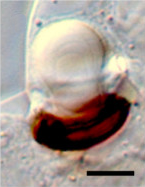Ocelloid

An ocelloid (not to be confused with ocellus , a multicellular point eye found in different animal groups) is a subcellular structure (i.e. a complex organelle ) found in single-celled dinoflagellates of the Warnowiaceae family (Warnowiiden). The structure and function of the ocelloid is analogous to the eyes of multicellular organisms that can focus, process and perceive light. The ocelloid is much more complex than an ordinary eye spot (a light-sensitive structure that is also found in unicellular organisms). Indeed, it is one of the most complex subcellular structures known and has been described as a striking example of convergent evolution.
history
The ocelloid was first described in 1884. Early descriptions were received with skepticism: they were believed to depict the eye of a multicellular organism that happened to be devoured by a unicellular organism. The possibility that there might be an evolutionary relationship to the plastids was considered from around the 1970s, although direct evidence was not available until 2010.
construction

Ocelloids contain substructures analogous to those of a real eye including the lens , cornea , iris and retina . The Ocelloid can be divided into two substructures: the translucent, round Hyalosom and the heavily pigmented melanosomes (also known as retinal body Retinalkörper or pigment cup called, English retinal body ). The hyalosome serves as the refractive lens of the ocelloid. It is surrounded by a layer of mitochondria that acts as the cornea and has conical rings that are analogous to the iris. The retina body has an inner structure of thylakoid membranes in chloroplasts recalls, and contains proteins, with the bacteriorhodopsin are used, a light-sensitive protein found in several archaea occurs.
Using genome analysis from single cells and electron microscopy it was demonstrated that the Ocelloid of several membrane-bound organelles different endosymbiotic origin is: There are several lineages peridinin -containing plastids involved. This discovery received widespread coverage in popular science media when it was reported in 2015
function
Due to the strong structural similarity between the ocelloid and the eyes of multicellular animals ( metazoa ), it has long been speculated whether the ocelloid functions as a photoreceptor. However, this was difficult to determine experimentally because Warnowiids cannot be cultivated in the laboratory and isolates from natural habitats degrade quickly. It has been shown that the morphology of the ocelloid changes in response to ambient lighting, that the ocelloid structure can be disturbed by exposure to extremely bright light, and finally that the ocelloid contains proteins with a similar sequence to known light-sensitive proteins. Therefore, it has been suggested that the ocelloid helps in spotting prey, possibly other dinoflagellates.
evolution
Ocelloids are considered a synapomorphic feature for the Warnowiids - that is, they are present in all Warnowiids and therefore probably also in their common ancestor, but not in the closest relatives, the polycricoid dinoflagellates ( Polykrikaceae ). However, these two groups share other unusually complex subcellular structures (i. E. Complex organelles) as nematocysts and Pistone (, pistons').
The molecular biological evidence that ocelloids consist of several endosymbionts is compelling, it is mitochondria and at least one type of plastid. Ocelloids are likely homologous to much less complex plastid-containing eye spots . Such are found in other (distantly related) dinoflagellates.
See also
Individual evidence
- ↑ a b c d e f g Gregory S. Gavelis, Shiho Hayakawa, Richard A. White III, Takashi Gojobori, Curtis A. Suttle, Patrick J. Keeling, Brian S. Leander: Eye-like ocelloids are built from different endosymbiotically acquired components . In: Nature . 523, No. 7559, 2015, pp. 204-207. doi : 10.1038 / nature14593 . PMID 26131935 .
- ^ Thomas A. Richards, Suely L. Gomes: Protistology: How to build a microbial eye . In: Nature . 523, no. 7559, July 1, 2015, pp. 166–167. doi : 10.1038 / nature14630 . PMID 26131934 .
- ↑ a b c M Hoppenrath, TR Bachvaroff, SM Handy, CF Delwiche, BS Leander: Molecular phylogeny of ocelloid-bearing dinoflagellates (Warnowiaceae) as inferred from SSU and LSU rDNA sequences. . In: BMC Evolutionary Biology . 9, May 25, 2009, p. 116. doi : 10.1186 / 1471-2148-9-116 . PMID 19467154 . PMC 2694157 (free full text).
- ^ A b Fernando Gómez, Purificación López-García, David Moreira: Molecular Phylogeny of the Ocelloid-Bearing Dinoflagellates and (Warnowiaceae, Dinophyceae) . In: Journal of Eukaryotic Microbiology . 56, No. 5, September 2009, pp. 440-445. doi : 10.1111 / j.1550-7408.2009.00420.x . PMID 19737196 .
- ↑ a b c d e f Shiho Hayakawa, Yasuharu Takaku, Jung Shan Hwang, Takeo Horiguchi, Hiroshi Suga, Walter Gehring, Kazuho Ikeo, Takashi Gojobori, Simonetta Gribaldo: Function and Evolutionary Origin of Unicellular Camera-Type Eye Structure . In: PLoS ONE . 10, No. 3, March 3, 2015, p. E0118415. doi : 10.1371 / journal.pone.0118415 . PMID 25734540 . PMC 4348419 (free full text).
- ^ Ed Yong: Single-Celled Creature Has Eye Made of Domesticated Microbes . National Geographic. July 2, 2015. Retrieved April 4, 2019 .. Vie WebArchive June 23, 2016.
- ↑ Single-celled predator evolves tiny, human-like 'eye' . July 1, 2015. Accessed April 4, 2019.
- ↑ Allison Eck: The Most Unbelievable Eye on Earth Belongs to a Creature With No Brain . PBS. July 16, 2015. Retrieved April 4, 2019.


